The International Monetary Fund (IMF) has recently approved a fresh $2.3 billion package for Pakistan. Out of this, $1 billion will be given immediately under the Extended Fund Facility (EFF), and $1.3 billion will come through a new Resilience and Sustainability Facility (RSF).
India chose not to vote on the package, pointing to Pakistan’s continued support for cross-border terrorism.
This development highlights a recurring pattern: Each time Pakistan knocks on the doors of the International Monetary Fund, it arrives with the same pitch: economic distress, low foreign exchange reserves, and inability to meet its external obligations. Each time, the IMF responds with a package, structured, conditional, but ultimately forgiving.
Also read: Indo-Pak War: Can Pakistan use F-16s against India? Here’s what the rules say
But one thing remains consistent: Pakistan’s military budget stays high, regardless of the economic condition or foreign aid it receives.

Pakistan’s IMF funding vs military spending Photograph: (WION)
Military budgets remain high even during bailouts
From 1999 to 2023, Pakistan received more than $22 billion in IMF disbursements. These funds were aimed at stabilising the country’s struggling economy and addressing balance-of-payments issues.
Yet in that same period, Pakistan spent over $180 billion on its military, often five to ten times more than the IMF money it got each year.
For instance, in 1999, Pakistan received about $611 million from the IMF, while spending $3.08 billion on defence. The pattern continued year after year, more aid came in, and more was spent on the military.
Year
IMF Funding in USD
Military Spending By Pakistan
1999
$611.6 million
3.08 billion
2000
$205.5 million
2.97 billion
2001
$505.5 million
2.84 billion
2002
$348.9 million
3.27 billion
2003
$499.6 million
3.72 billion
2004
$256.7 million
4.13 billion
2005
0
4.59 billion
2006
0
4.97 billion
2007
0
5.34 billion
2008
$3.18 billion
5.23 billion
2009
$3.30 billion
5.27 billion
2010
$1.64 billion
5.97 billion
2011
0
6.95 billion
2012
0
7.48 billion
2013
$1.09 billion
7.66 billion
2014
$2.16 billion
8.68 billion
2015
$2.03 billion
9.51 billion
2016
$1.10 billion
10.00 billion
2017
0
11.38 billion
2018
0
11.54 billion
2019
$1.44 billion
10.22 billion
2020
$1.41 billion
10.24 billion
2021
$500.5 million
11.65 billion
2022
$2.22 billion
10.36 billion
2023
$1.20 billion
8.52 billion
Military spending through the years
Here’s a comparison of some key years showing IMF bailouts versus Pakistan’s military spending:
2008 (Global Financial Crisis)
IMF aid: $3.1 billion
Military spending: $5.23 billion
2013–2014 (Debt and Energy Crisis)
IMF aid: $2.18 billion
Military spending: $8.68 billion
2019 (Balance of Payments Crisis)
IMF aid: $1.37 billion
Military spending: $10.4 billion
2022 (Pandemic and inflation)
IMF aid: $2.18 billion
Military spending: $10.34 billion
Even as the IMF sent money to help stabilise the economy, defence budgets remained unaffected. Fuel subsidies were slashed, taxes were increased, and inflation hit record highs, but the military continued to get its share.
In 2023, defence spending was nearly 7 times the IMF aid
In 2023, Pakistan faced a risk of default, and inflation soared above 30%. The IMF disbursed $1.2 billion. But during that same year, Pakistan’s military budget stood at $8.52 billion, nearly seven times the aid.
In 2021, the IMF asked Pakistan to raise taxes and cut energy subsidies. Instead, the country raised its defence budget to $11.84 billion, its highest in recent memory.
IMF programmes typically come with strict conditions: Raise taxes, reduce subsidies, and cut government spending.
But Pakistan’s military budget has remained largely outside these conditions.
A 25-year pattern with no reforms
What’s clear is that this isn’t a one-off case. Over the last 25 years, Pakistan has followed a consistent pattern:
IMF loans increase → Military spending increases faster
Economic crises worsen → Military budgets remain untouched
Austerity hits civilians → Defence remains protected
Pakistan’s economic challenges are routinely treated as external issues of bad debt, weak exports, etc. But they are deeply political. The military’s dominance of national resources takes precedence over civilian priorities like education, healthcare, and development.
The numbers show this isn’t just a question of prioritisation but it’s how Pakistan governs.
